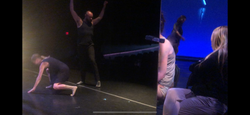top of page
Working Archive
click on the images to learn more
 Devising the Performance Environment |  Devising the Performance Environment, continued. |  In science, indirect observation occurs when the observation or measurement of one thing facilitates the observation or measurement of a different thing. Sometimes referred to surrogate observation, in this research indirect observation occurs when spectators gaze into the mirror and therefore through themselves to observe dancing bodies. |
|---|---|---|
 Perception is a process that includes sensing, interpretation and response and is the construction of visual information. In this research, individualized spectator perception (exposed by gaze directed into the mirror and indirectly onto the dancing bodies) is harnessed to both represent the ‘observer-effect’ and demonstrate the causality between perception and reality. “Ultimately, what we perceive determines what we know and what we think is real” (Olsen). |  This diagram provides rationale for the sub-aim of my current research: The sub aim is to heighten the visual experience of the spectator in order to highlight the conscious construct of perception and draw attention to the pathways of visual contextualization that centers the act of perception on the perceiver and not the perceived. The performance environment was conceived in part based on the development of the sub-aim. |  Direct observation from the spectator determines the dancer's location. They become a fixed entity in spacetime until the spectator turns back towards the mirror and observes movement indirectly. Seen in the relationship between Sara on the floor and Ana a spectator (the observer turned around in the chair). The spectator is free to make direct observation at-will, creating indeterminate timing for the dancer, the movement phrase and manipulating dynamics of intersubjectivity. |
 Context is defined by the interrelationships between past, present and future. Present is equated with immediate stimulation processing however often comprehended through the lens of historical familiarity. Therefore, immediate perception is often shaped by association. Visual consciousness is the method of processing visual stimuli. There are three primary aspects of visual consciousness, phenomenal (experience), access (content) and reflexive (awareness of the self in relation to experience). |  Visual contextualization is a hybrid term that refers to the subconscious constructs assigned to visual stimulation. This research provokes the politics of perception by fixing gaze into the mirror and indirectly onto dancing bodies. The configuration suggests that the self as the vessel of perception is permeated by historical familiarity and therefore identity politics. This research seeks to achieve immediate context awareness that requires extraction, capture, and interpretation. |  Creating a movement task with the intent to combine the quantum principle of tunneling with electromagnetism, generated from a place of natural occurrence based on the exchange of energy between dancers. |
 Based on the doing, undoing and redoing of movement this phrase applies the energey from retrograde movement to the 'redo' of movement to influence a pathway that complments but varies from the original movement trajectory. |  This image shows direct observation (through the mirror onto the entanglement duet) and indirect observation (onto the three dancers upstage) The bi or tri-directional gaze is built to manipulate perception-based expectation. |  Reviewing the evolved entanglement duet I recognized a bulk of transitional movement. Therefore, I tasked the participating dancers with physicalizing the principle of the quantum leap theory, in attempt to achieve movement from one action/reaction to the next with no transition. The resulting ‘string of incidents’ reflects the negotiation of continuously shifting, shared energy and increases phrase dynamics by encouraging urgency in the movement. |
 The outcome of embodied counterpoint emerged from the attention to moving in a state of entanglement without impetus of devising a phrase with counterpoint. Reflecting on the process, viewing the choreographic phrase and reinstantiating the movement demonstrates that harmonic counterpoint may be a result of the participating dancers embodying the principle of entanglement and maintaining the integrity of the reciprocal relationship. |  The phenomenon that occurs when quantum particles cannot be described independently even when separated by distance. Intra-action is an extension of entanglement, developed by Physicist Karen Barad. According to Barad, “To be entangled is not simply to be intertwined with one another, as in the joining of separate entities, but to lack an independent, self-contained existence. Existence is not an individual affair.” Intra-action presupposes a oneness in constitution of entangled particles. |  Happened upon in the movement discovery of entanglement/intra-action, during movement exploration and through the frame of action/reaction, my partner and I developed an unspoken commitment to contracting and expanding the space between our two bodies. During the in-and-out of the space between, which I will refer to as the ‘third culture’ I felt magnetism. Speaking with my partner, they also felt an attraction to manipulating the third culture. |
 Oral presentation, questions and feedback. |  |  |
 |  |
bottom of page